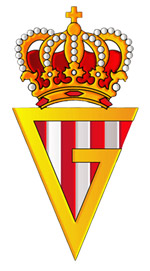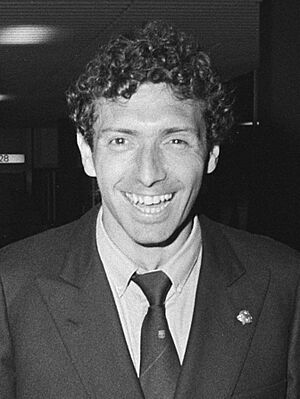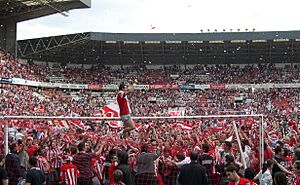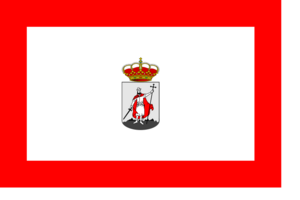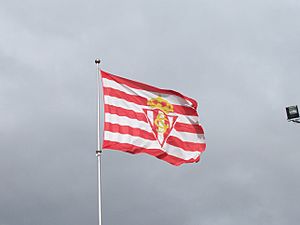Sporting de Gijón facts for kids
 |
||||
| Full name | Real Sporting de Gijón, S.A.D. | |||
|---|---|---|---|---|
| Nickname(s) | Rojiblancos (Red-and-Whites) | |||
| Short name | RSG, Sporting | |||
| Founded | 1 July 1905 (as Sporting Gijonés) | |||
| Ground | Estadio Municipal El Molinón – Enrique Castro "Quini" | |||
| Capacity | 29,371 | |||
| Owner | Grupo Orlegi | |||
| President | Alejandro Irarragorri | |||
| Head coach | Asier Garitano | |||
| League | Segunda División | |||
| 2022–23 | Segunda División, 17th of 22 | |||
|
||||
Real Sporting de Gijón is a professional football club from Gijón, Asturias, Spain. It was founded on July 1, 1905. The team is known as Los Rojiblancos (The Red-and-Whites) because of their red and white striped jerseys. They play their home games at El Molinón stadium, which is the oldest professional football ground in Spain.
Sporting Gijón had its most successful years in the 1970s and 1980s. During this time, they finished as runner-up in the top Spanish league, La Liga, in the 1978–79 season. They also reached the finals of the Copa del Rey (King's Cup) twice, in 1981 and 1982. Sporting Gijón is one of only nine Spanish teams that have never played below the second division. Their main local rival is Real Oviedo.
Contents
Club History
Early Years: 1905–1940
The club started in 1905 as Sporting Gijonés. Anselmo López was the first president. Their first recorded game was on August 18, 1907. Sporting Gijonés quickly became the top team in the city. In 1912, King Alfonso XIII gave the club his royal support. This led to the club adding "Real" (meaning Royal) to its name, becoming Real Sporting Club Gijonés.
In 1914, Sporting Gijón won its first Regional Championship of Asturias. Two years later, the club began steps to buy El Molinón stadium, where they had been playing since 1915. On April 2, 1916, the club changed its name again to its current one, Real Sporting de Gijón. They played in the Copa del Rey for the first time in 1917. In 1929, Sporting Gijón joined the Segunda División, which is Spain's second-highest football league.
The Real Gijón Era: 1940–1970
From 1940 to 1970, the club's official name was Real Gijón. This was due to a rule that stopped football clubs from using foreign words in their names.
In 1944, the club was promoted to La Liga, the top Spanish league, for the first time. Their first game in La Liga was on September 24, 1944. For many years, Sporting moved between the first and second divisions. In the 1960s, they spent the whole decade in the Segunda División.
The Golden Years: 1970–1992
In 1970, the club got its "Sporting" name back. This marked the start of a very successful period. Even after being relegated in 1975, they quickly returned to La Liga in 1976.
The 1978–79 season was one of the best in the club's history. Players like Quini, Cundi, and Enzo Ferrero helped the team finish second in La Liga. This was their highest-ever finish. They also played in the UEFA Cup for the first time.
In 1981, Sporting played in the Copa del Rey final for the first time but lost to FC Barcelona. The next year, in 1982, they reached the final again but were defeated by Real Madrid CF. During the 1980s, Sporting played in the UEFA Cup four more times. In 1987, they even beat A.C. Milan in the first game of a UEFA Cup match. The club played its 1,000th game in La Liga in 1992.
Club Challenges: 1992–2008
In 1992, Real Sporting de Gijón became a sports company, Real Sporting de Gijón, S.A.D. Financial problems and players leaving led to the club's decline. In 1998, after 21 years in La Liga, Sporting was relegated back to the Segunda División.
The club faced serious financial difficulties in the 2000s. They even had to sell their training ground, Escuela de Fútbol de Mareo, in 2001 to help with debts. Despite these challenges, they almost got promoted back to La Liga in the 2003–04 season.
Return to La Liga: 2008–2012
Under coach Manuel Preciado, Sporting Gijón earned promotion back to La Liga on June 15, 2008. They beat SD Eibar in the final game of the season.
In their first season back in La Liga (2008–09), Sporting had some big wins. They beat Valencia CF 3–2 and Sevilla FC 1–0. They managed to avoid relegation on the very last day of the season. In 2011, they famously beat Real Madrid CF 1–0 at their home stadium, ending Real's long unbeaten run there. This was a great season for the club, as they finished 10th. However, in the 2011–12 season, the team struggled and was relegated again.
Young Talent and New Challenges: 2014–Present
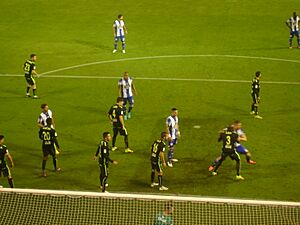
In 2014, Abelardo Fernández became the head coach. In the 2014–15 season, Sporting was not allowed to sign new players from outside their reserve team due to financial issues. Despite this, the team, made up mostly of young players from their academy (nicknamed Los Guajes, meaning "The Kids"), achieved promotion back to La Liga. They finished second in the Segunda División with only two losses all season.
In their return to La Liga (2015–16), they still faced player signing limits. However, they managed to stay in the top league again, avoiding relegation on the last day. Abelardo left the club in 2017, and Sporting was relegated once more.
For several years, Sporting remained in the Segunda División. In 2022, Abelardo returned briefly to help the team avoid relegation to the third division. On June 28, 2022, a Mexican group called Orlegi Sports bought the club. Alejandro Irarragorri became the first foreign president. In 2024, Sporting Gijón reached the promotion play-offs for La Liga but was eliminated by RCD Espanyol.
Club Colours and Crest
Real Sporting de Gijón has worn red and white striped jerseys since the club began. They were the first Spanish team to use these colours. The red and white come from the official flag of Gijón. For many years, their shorts were blue, and their socks were also blue. In the 1990s, they wore white shorts and socks, but fans voted to bring back the traditional blue.
The club's badge is a triangle with red and white stripes. It has the letters 'S' (for Sporting) and 'G' (for Gijón) intertwined in gold. A crown at the top shows the club's royal support.
Kit Manufacturers and Shirt Sponsors
| Period | Kit manufacturer | Shirt sponsors |
|---|---|---|
| 1979–1986 | Adidas | none |
| 1986–1989 | Cajastur | |
| 1989–1991 | Rasán | |
| 1991–1993 | Lotto | |
| 1993-1994 | Cajastur Asturias |
|
| 1994–1997 | Joma | |
| 1997–1999 | Astore | none |
| 1999–2001 | Gijón | |
| 2002–2011 | Gijón Asturias |
|
| 2011–2013 | Kappa | |
| 2013–2016 | Gijón | |
| 2016–2017 | Nike | |
| 2017–2018 | Teslacard | |
| 2018–2019 | Pastón | |
| 2019–2020 | Interwetten | |
| 2020–2022 | Integra Energía Gijón |
|
| 2022–2024 | Puma | |
| 2023–2024 | Jalisco | |
| 2024–present | Siroko |
Home Kit Evolution
|
1905–1910s
|
1905–1984
|
1984–1989
|
1989–1997
|
1997–2023
|
2023–present
|
Stadium
El Molinón is the home stadium for Sporting de Gijón. It can hold 29,371 fans.
Sporting started using El Molinón in 1915. Before that, they played in different areas of Gijón. In 2018, the stadium was renamed El Molinón-Enrique Castro "Quini" to honor Quini, the club's all-time top scorer, after he passed away.
Academy
The Escuela de Fútbol de Mareo is Sporting de Gijón's training ground and youth academy. It opened on March 28, 1978. The club's main offices are also located there.
Mareo is about 7 kilometers from the city center. It covers a large area and has eight football pitches. It also has a gym and a medical center. The main pitch, where the reserve team Sporting de Gijón B plays, is called Campo Pepe Ortiz.
Mareo is famous for developing many talented football players. Some well-known players who trained there include Luis Enrique, Abelardo, and David Villa. David Villa even won the World Cup with the Spanish national team in 2010.
Supporters
Sporting de Gijón fans are called Sportinguistas. They are known for being very loyal and traveling in large groups to support their team. When they travel together, they are called La Mareona, which means The Big Tide. This group is made up of about 240 fan clubs.
In June 2008, about 300,000 fans celebrated when Sporting was promoted to La Liga. The club has a strong fan base, with many season ticket holders each year.
Rivalries
Sporting de Gijón's biggest rival is Real Oviedo. Their matches are known as the Asturian derby.
Club Achievements
National Titles
- La Liga:
- Runner-up: 1978–79
- Copa del Rey:
- Runner-up: 1981, 1982
- Segunda División:
- Winners: 1943–44, 1950–51, 1956–57, 1969–70, 1976–77
- Runner-up: 1929–30, 2014–15
Individual Player Awards
Pichichi Trophy (Top Scorer)
- La Liga: Quini (3 times: 1973–74, 1975–76, 1979–80)
- Segunda División: Ricardo (1956–57), Solabarrieta (1966–67), Quini (2 times: 1969–70, 1976–77)
Zamora Trophy (Best Goalkeeper)
- La Liga: Ablanedo II (3 times: 1984–85, 1985–86, 1989–90)
- Segunda División: Roberto (2005–06), Cuéllar (2014–15)
Seasons Played
Sporting de Gijón has played:
- 42 seasons in La Liga (the top division)
- 53 seasons in Segunda División (the second division)
Sporting de Gijón in European Football
Sporting de Gijón has played in the UEFA Cup six times. They advanced past the first round in two of those appearances.
| Season | Competition | Round | Opponent | Home | Away | Agg. |
|---|---|---|---|---|---|---|
| 1978–79 | UEFA Cup | R64 | 3–0 | 0–1 | 3–1 | |
| R32 | 0–1 | 1–1 | 1–2 | |||
| 1979–80 | R64 | 0–0 | 0–1 | 0–1 | ||
| 1980–81 | R64 | 2–1 | 1–3 | 3–4 | ||
| 1985–86 | R64 | 1–2 | 0–0 | 1–2 | ||
| 1987–88 | R64 | 1–0 | 0–3 | 1–3 | ||
| 1991–92 | R64 | 2–0 | 0–2 | 2–2 | ||
| R32 | 2–2 | 0–1 | 2–3 |
Players
Current Squad
|
|
Reserve Team
Sporting Gijón also has a reserve team, Sporting Atlético, and a C team.
|
|
Club Staff
Current Technical Staff
Club Management
Board of Directors
| Role | Name |
|---|---|
| President | Alejandro Irarragorri |
| Executive presidente | David Guerra |
| Director of Football | Gerardo García |
| Club Ambassador | Joaquín Alonso |
Club Budgets
| Season | Division | Budget (€) |
|---|---|---|
| 2013–14 | Segunda | 14,099,300.00 |
| 2014–15 | Segunda | 11,884,180.00 |
| 2015–16 | La Liga | 31,278,634.45 |
| 2016–17 | La Liga | 43,785,450.00 |
| 2017–18 | Segunda | 23,286,465.00 |
| 2018–19 | Segunda | 24,138,980.00 |
| 2019–20 | Segunda | 23,772,801.00 |
| 2020–21 | Segunda | 20,851,230.00 |
Women's Team
Sporting Gijón also has a women's football team. It started in 1995 and became an official part of the club in 2016. The team currently plays in the third division, called Segunda Federación.
Other Sections
In the past, Sporting Gijón also had teams for athletics, handball, and rugby union.
See also
 In Spanish: Real Sporting de Gijón para niños
In Spanish: Real Sporting de Gijón para niños
- Sporting de Gijón B – Sporting de Gijón's reserve team.
- Trofeo Villa de Gijón


